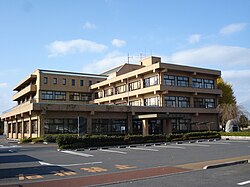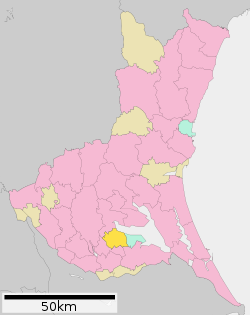|
Ami, Ibaraki
 Ami (阿見町, Ami-machi) is a town located in Ibaraki Prefecture, Japan. As of 1 October 2020[update], the town had an estimated population of 47,927 in 20,279 households and a population density of 671 persons per km2. The percentage of the population aged over 65 was 28.3%.[1] The total area of the town is 71.40 square kilometres (27.57 sq mi). GeographyLocated in southern Ibaraki Prefecture, Ami is bordered to the north by Lake Kasumigaura Surrounding municipalitiesClimateAmi has a Humid continental climate (Köppen Cfa) characterized by warm summers and cool winters with light snowfall. The average annual temperature in Ami is 13.8 °C. The average annual rainfall is 1306 mm with September as the wettest month. The temperatures are highest on average in August, at around 25.7 °C, and lowest in January, at around 2.8 °C.[2] DemographicsPer Japanese census data,[3] the population of Ami has recently plateaued after a long period of growth.
HistoryDuring the Edo period, the area around Ami was part of Hitachi Province. The villages of Ami, Kimihara, Asahi and Funashima were created with the establishment of the modern municipalities system on April 1, 1889. In 1921, the Imperial Japanese Navy established Kasumigaura Air Field, a naval aviation training base at Ami, with floatplane operations on nearby Kasumigaura. Zeppelin operations also began from 1929. In 1937, the Youth Aviation Squadron was transferred from Yokosuka. The base was repeatedly bombed in 1944 and 1945 during World War II, with the attack on June 10, 1945 killing over 300 people. On April 1, 1955, the villages of Ami, Kimihara and Asahi merged to form the town of Ami. Most of the village of Funashima joined on April 20, 1955. GovernmentAmi has a mayor-council form of government with a directly elected mayor and a unicameral town council of 18 members. Ami contributes one member to the Ibaraki Prefectural Assembly. In terms of national politics, the town is part of Ibaraki 6th district of the lower house of the Diet of Japan. EconomyAmi has a mixed economy. Agriculture remains predominant; however, there are also numerous factories for chemicals, light manufacturing and electronics. The Japanese Ground Self-Defense Force also has a number of military installations in the town. Education
TransportationRailway
Highway
Military facilities
Local attractions
International relations
References
External links
|
|||||||||||||||||||||||||||||||||||||||||||||||||||||||||||||||||||||||||
Portal di Ensiklopedia Dunia




